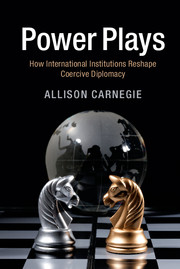Book contents
- Frontmatter
- Contents
- Figures
- Tables
- Acknowledgments
- 1 Introduction
- 2 Theoretical Framework
- 3 Bilateral Agreements and State Similarity
- 4 WTO Membership as a Commitment Strategy
- 5 Coercive Diplomacy in Comparative Perspective
- 6 Agreements and the Displacement of Coercion
- 7 Reduced Effectiveness of Coercion: Evidence from the United States
- 8 Conclusion
- Bibliography
- Index
2 - Theoretical Framework
Published online by Cambridge University Press: 05 November 2015
- Frontmatter
- Contents
- Figures
- Tables
- Acknowledgments
- 1 Introduction
- 2 Theoretical Framework
- 3 Bilateral Agreements and State Similarity
- 4 WTO Membership as a Commitment Strategy
- 5 Coercive Diplomacy in Comparative Perspective
- 6 Agreements and the Displacement of Coercion
- 7 Reduced Effectiveness of Coercion: Evidence from the United States
- 8 Conclusion
- Bibliography
- Index
Summary
To gain insight into the relationship between political hold-up problems and coercive diplomacy, I develop a formal, game-theoretic model. Although I cannot provide a fully specified account of coercive diplomacy because of the complexity of such an endeavor, this basic model strives to elucidate states’ key considerations when they attempt to coerce their partners. In so doing, I generate testable empirical hypotheses, providing the foundation for the empirical analysis conducted in the remainder of the book.
The model features two states, a Coercer and a Target. At the beginning of the game, the Target must decide whether to make an irreversible investment that would allow it to produce a good to export to the Coercer. Next, with some probability, a shock occurs that increases the Coercer's desire to influence the Target's behavior. In the advent of a shock, the Coercer may offer threats and assurances to the Target using some combination of tariff and foreign aid policies in exchange for foreign policy concessions. However, if the states are WTO members, the Coercer cannot alter its tariff policy for these coercive purposes. After it receives the offer, the Target chooses whether to accept it, and the game ends.
This simple model predicts that the Target will not invest when it expects the Coercer to use its tariff opportunistically. This risk is greater when the Coercer wields more power than the Target and when the probability of a shock is high, which occurs when the states have dissimilar policy preferences. However, the states can use WTO membership to circumvent these political hold-up problems because the WTO requires the Coercer to commit to not manipulating its tariff policies to extract concessions. The Coercer can, for example, increase its use of foreign aid instead, although this results in diminished leverage over the Target.
- Type
- Chapter
- Information
- Power PlaysHow International Institutions Reshape Coercive Diplomacy, pp. 19 - 45Publisher: Cambridge University PressPrint publication year: 2015



